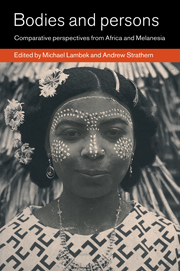Book contents
- Frontmatter
- Contents
- List of illustrations
- List of contributors
- Acknowledgments
- 1 Introduction: Embodying sociality: Africanist–Melanesianist comparisons
- Part I Transcending dichotomies
- Part II Transitions, containments, decontainments
- Part III From exchange to history
- 9 Creative possessions: spirit mediumship and millennial economy among Gebusi of Papua New Guinea
- 10 Dis-embodiment and concealment among the Atbalmin of Papua New Guinea
- 11 Melpa and Nuer ideas of life and death: the rebirth of a comparison
- 12 Afterword: embodying ethnography
- Bibliography
- Index
9 - Creative possessions: spirit mediumship and millennial economy among Gebusi of Papua New Guinea
Published online by Cambridge University Press: 05 June 2012
- Frontmatter
- Contents
- List of illustrations
- List of contributors
- Acknowledgments
- 1 Introduction: Embodying sociality: Africanist–Melanesianist comparisons
- Part I Transcending dichotomies
- Part II Transitions, containments, decontainments
- Part III From exchange to history
- 9 Creative possessions: spirit mediumship and millennial economy among Gebusi of Papua New Guinea
- 10 Dis-embodiment and concealment among the Atbalmin of Papua New Guinea
- 11 Melpa and Nuer ideas of life and death: the rebirth of a comparison
- 12 Afterword: embodying ethnography
- Bibliography
- Index
Summary
In recent years, notions of power and resistance have often informed anthropological understandings of spiritual experience and embodiment. The entranced individual can be viewed as pushing against inequities bequeathed by political domination, gender, race, or age. Providing a voice for the disempowered, the possessed persona can be considered the colonial subject crying out against colonialism, the woman resisting patriarchy, the youthful agent protesting gerontocracy, the heathen subverting Christianity or Islam, or the spiritual gift economy resisting the market. In various permutations, such views are common in works on spirit possession and millenarianism in Africa and Melanesia, including classic studies such as Lanternari's Religions of the Oppressed (1963), Worsley's The Trumpet Shall Sound (1968), and Lewis's Ecstatic Religion (1971). More recently, local expressions and idioms of spirituality have been seen to contradict and destabilize the assumptions upon which state or Western logics of control are founded. This point has been elaborated by Michael Taussig (1987, 1993), Anna Tsing (1993), Mary Steedly (1993), and Smadar Lavie (1990), among others. As Boddy (1994:419) notes in a recent review, “most would agree that possession cults are or have become historically sensitive modes of cultural resistance.”
Amid signal contributions, however, such portrayals easily partake of what Abu-Lughod (1990) calls the romance of resistance. And as Ortner (1995) has recently noted, there is a tendency for studies of resistance to be ethnographically thin rather than rich. Analogously, treatments of spiritual imagination and mimesis can be frustratingly vague at the same time that they can be suggestive and stimulating.
- Type
- Chapter
- Information
- Bodies and PersonsComparative Perspectives from Africa and Melanesia, pp. 197 - 209Publisher: Cambridge University PressPrint publication year: 1998
- 1
- Cited by



